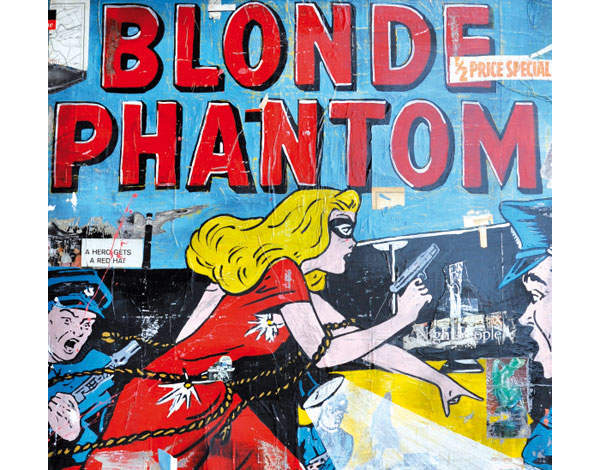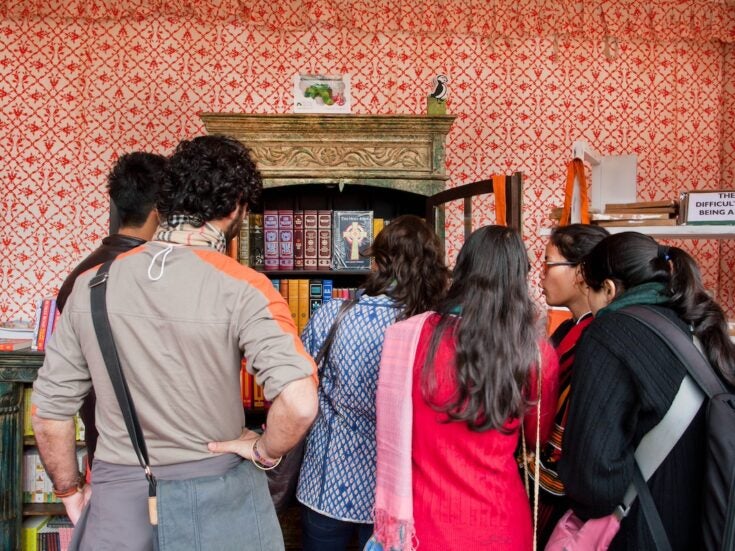

POP GOES THE EASEL
Most of the art world’s ‘-isms’ began as gangs. Or perhaps cults. The Impressionists were the proud rejects: the Salon des Refusés! Picasso and Braque explored Cubism ‘roped together like mountaineers’, in Braque’s famous words. Dada had a clubhouse (the Cabaret Voltaire) and hardcore Dadaists like Richard Huelsenbeck snubbed their successors, the Surrealists.
The Surrealists’ leader, André Breton, routinely ‘deep-sixed’ followers who got out of line. The Abstract Expressionists flexed throats and muscles at the Eighth Street Club and the Cedar Tavern. I could go on.
Then there was Pop.
The artists who would be enlisted as Pop, both in the US and Europe, shared such characteristics as a distaste for the Sturm und Drang of the Ab Exes and a taste for throwaway culture, but they were less a gang than a sensibility. Abstract Expressionism would prove as short-lived as jazz, becoming posh décor in the hands of the next generation, but the grip of Pop, both on the culture and the marketplace, has, if anything, tightened. Great? No.
Read more on Pop art from Spear’s
There’s a downside, like admen ripping off Roy Lichtenstein, oblivious to the ironies, and a tsunami of galleries flogging sub-Warholesque kitsch. Pop artists thrillingly channelled the environment and so does this stuff, but the environment it channels is… Pop art itself. Usually Warhol. How many Marilyn hairdos affixed to Bernie Madoff or Julian Assange do we need to see?
There’s an upside, though. Pop artists’ sources were the postwar consumerist culture they had grown up with and saw around them — comic books, grungy TV, tabloids, cheesy ads, Hollywood. Yes, Low Culture. So Pop art thrummed with exuberance, but for art world cognoscenti it was also a kind of delicious slumming.
Well, that material environment has evolved. Thanks to chi-chi branding, saturation marketing, social media and so on, most of us at whatever level live in a Pop world these days. You would expect artists to be exploring this territory, and you would be right. But, just like the Pop originals, they are less a gang than a sensibility and it is interesting that many of them began outside the mainstream gallery world. In a nod to Popism, Warhol’s swell book, let’s call it ‘PostPopism’.
White mischief
Eric White, who is from Michigan, studied illustration at the Rhode Island School of Design, then moved to California. ‘I was doing pretty well,’ he says. ‘But I got bored really quickly. And I started to have these ideas that I couldn’t express through that.’ This wasn’t that long ago, but it was pre-internet, so in terms of info it was another age. White saw paintings by Ashley Bickerton in New York, and a reproduction of Peter Blake’s On the Balcony. ‘That changed my life,’ he says. ‘I began doing my own stuff on the side.’
White moved to New York and his stuff became quite strange, often with a narrative dimension, such as his movie ads. ‘They are for invented movies that are loosely based on mythological events or bizarre curatorial ideas,’ he says. ‘I read about this guy that has a theory that the moon is actually a solid object, and that when struck by something it rings like a bell. And that was enough for me to take off on a painting, since that idea is so insane.’
Some of the paintings include the word ‘Vril’. This denotes an energy form in The Coming Race, the 1871 novel by Edward Bulwer-Lytton, that was taken for raw truth by the Nazis as the Scientologists took L Ron Hubbard. ‘I read about it a few years ago and it’s been in my mind ever since,’ White says. ‘There’s something called the Vril Society. And there were these five women who were Hitler’s psychics. They were working on UFO technology. Anything insane like that is really exciting to me.’
Read more by Anthony Haden-Guest from Spear’s
Jordan Doner was a successful commercial photographer for various Bazaars, Vogues and the chunky glossies, which have become as much part of Pop culture these days as superhero franchises and branded tattoos. ‘But I was always working on ideas that weren’t commercial photography,’ he says.
In the autumn of 2009 Doner began creating photographic Utopias. Dream lives, barely imaginable pleasures, indeed just the kind of sensual continuum you can enter when you leaf through a glossy magazine. It was while he was researching ways of depicting these that Doner watched Michelangelo Antonioni’s only America-based movie, Zabriskie Point. ‘There’s a love scene in the desert where intertwined couples roll naked down the dunes, kicking up dust into the desert sun,’ he says.
But just as in the real world, the road from Utopia to Dystopia was a hop, skip and jump. At the end of Zabriskie Point, the fancy house explodes, at least in the imagination, and consumer items are blown sky-high. This led Doner into the world of high-end branding, and the result has been super-sharp photographs showing fragments of high-end consumer items mid-detonation, such as Louis Vuitton bags designed by Murakami and Richard Prince. The technicians who exploded the luxe were Grucci, the firework maestros who will be executing the follow-up.
‘I’ll be shooting films,’ Doner says. ‘Each explosion will be 45 seconds to a minute and a half. You’ll really see the stuff coming apart; you’ll really see the debris hanging in space.’ Where will the shoot be? ‘I want to get as close as I can to Zabriskie Point.’
Poster boy
Greg Miller, who had a show of his mixed-media paintings in the Scream Gallery in London last year, works in studios in Los Angeles and Austin, Texas, and will soon also be in Springs, Long Island, but he grew up in northern California.
Miller notes: ‘I didn’t go to Venice, Italy, to entrench myself in ancient frescoes.’ What he absorbed was today’s fresco equivalents: billboards. So, of course, did Lichtenstein, Rosenquist, Warhol — but whereas the Popsters had a cool, deadpan take on such material, Miller is a romantic.
‘The billboards were all ripped and really blowing in the wind. When I would see them I would get a sense of time, history. Much of the language and imagery was commercial — Hires root beer, Coca-Cola — but they were kind of abstract too. And in the background there was this vast landscape of powder blue and sandy light mountains. I had this love affair with it as I sat in the back of my dad’s Jeep. And the images did haunt me — they still do.’
That became a source of Miller’s strength. ‘I have always liked to paint. I really wanted to document that language and that imagery and then add to it with other things I found on the street. Little pieces I have found and collected. They are part of the romantic story I tell in the context of each painting.’
Deconsumptionism, the current project of Paul Lamarre and Melissa Wolf, a New York duo who operate as Eidia, is housed in a 48ft tractor-semi-trailer, parked in Williamsburg, Brooklyn. ‘We collect objects,’ says Lamarre. The collections are archived in 171 boxes, wrapped in hazard-orange plastic, and when they go on show they are exhibited both as is and grouped in a still-life photograph. Which objects? Well, key to the development of the concept was their collection of plastic bags.
Yes, like supermarket bags.
‘We chose bags that we felt were interesting,’ Wolf says. ‘We did laser Xeroxes of them and made installation pieces.’
‘In Torino, Italy, it was on the floor,’ Lamarre says. ‘It was on the wall in Tubingen, Germany.’
In what sense ‘interesting’, I asked. ‘In Eastern Europe in the early Nineties, bags were decorative because they were meant to be used over and over,’ said Wolf. ‘Not like America, where they are just thrown away.’
‘Do we really need to produce more stuff?’ asked Lamarre. ‘Do we need more plastic bags? And what happens to what we do produce? The design of today is the landfill of tomorrow.’
Commercial eye
So to another Greg (just add a G). Gregg LeFevre, a Boston artist, moved into public art because of a distaste for the way the art world works. ‘If you really make it in the gallery world your art ends up in a bank vault. I wanted my work to be seen,’ he says. It was while he was installing his sculptures downtown in various cities that he noticed how the cityscapes were changing.
‘It was at the very beginning of this new movement in advertising when they developed the ability to stretch vinyl and canvas over any surface,’ he says. ‘They were using big prints, photographs. Now they have stuff glued in the street, they have stuff on cabs, ads are everywhere. And that really changed the urban landscape.’
LeFevre began shooting pictures out of his pilot mother’s plane as a little boy. He began to document these changes. ‘When an ad is in a magazine or in a newspaper or on television it keeps its integrity,’ he says. ‘But when you put an ad, a three-dimensional object, in public, even though it’s an eighth of an inch, things happen to it. People attack it, they deface it, dogs piss on it. It’s an object in space.’
LeFevre is now coming to terms with the way the art world works. Last reached, he was at a show of his work in Beijing.







